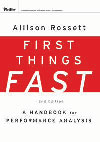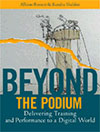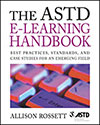Sue got caught texting while sitting in her car at a stoplight. She was just sitting there when law enforcement nabbed her. But that’s another matter.
We are here to talk about how Sue dealt with the ticket she got. In California, those of us who get tickets may reduce the penalty via traffic school. Some turn to Clown Traffic School or my personal favorite, Shop ’til You Drop Traffic School. There are even gay and lesbian training options. Sue decided that e-learning made the most sense for her. She did it for the usual reasons associated with online education: access on demand, novelty, and location, location, location.
She paid up. Then she procrastinated. Finally, she signed on. Sue’s online lessons offer up lessons for those involved with e-learning.
How did it go for you, Sue? Please describe what happened when you went online. There were seven modules, each with sub-modules 5-8 pages in length. Sue said, “I was startled to see pages of text, lengthy pages, all longer than my screen and requiring scrolling. That was annoying. After every page, every page, they seek feedback. That too was annoying. And I can’t figure out what I’m supposed to learn from each module. That’s most annoying.”
She continued, “There were some videos, but I don’t think they use video capabilities as well as they might. Well, I might be being too negative here. There were videos that attempted to communicate the sorrow associated with death caused by vehicular accidents. That was a good idea. They were emotional, but for some technical reason, bandwidth perhaps, they were broken into four short segments. That dulled their power for me.”
You described some of the content of the modules. Can you share? Sue described it as an onslaught of driving-related factoids. While complaining, she acknowledged that some morsels grabbed her attention.
- Most bad driving things happen between 5 and 6 PM.
- Bad things happen in the 18th hour after you have awakened.
- 12% of drivers are doing personal grooming while driving.
- There were many facts about men and women and how they drive differently. Sue couldn’t remember any details.
- Cold medicine does bad things to driving ability. So do alcohol, fatigue and drugs.
- Accidents happen in bad weather.
There was a tendency to state the obvious, all with breathless encouragement to WATCH OUT. Vigilance during bad weather is one good example. It is very important to be careful when the weather is inclement. Be sure to inspect the automobile every time you get into it. This was revealed in a full page of text.
You misbehaved in a particular way. Did the lessons target your behavior or personalize? “No, there was little attention to texting. It was one item in a long list of concerns for drivers. Unlike other topics, they did not numb me with details on my pecadillo, texting.”
I know you took tests. Please tell us about them and their value. There were ten multiple choice items for each test at the end of the modules. Sue reports that she thinks she could have passed the tests without reading the modules. For one module, Sue jumped to the test when she got bored. She reports that she got 100% on that one. She also noted that the test questions only partially reflected what she decided was most important in each module. The system gave her feedback on how she did, but did not serve up correct answers on the items she flubbed.
Every so often, there was a pop-up question to verify that Sue was taking this test, not her cat. They threaten penalties for not-being-Sue and attempt to make certain it is Sue by asking questions based on data collected at the beginning of the course, for example, information about visits to foreign countries and cities in which she has resided. These are things the cat does not know.
Are there any strategies there that might encourage better driving behavior? Sue paused and then expressed appreciation for one aspect of the program. What she dubbed “the deluge of facts” successfully nudged her to reflect on her driving and other people’s driving as well. This item garnered her attention: Drivers make 20 decisions per mile and 2 of those are mistakes. Sue thought with humility about her own driving, and of course, she looked with concern at the drivers surrounding her on the road. She said she is more cautious, “I notice that now, as I am completing the online program, my awareness is up. I’m thinking more about risks, f0llowing distance, and about fatigue on the road.”
This is good. Will it last? “No, it won’t,” she responded. No hesitation.
Net, net, what do you think? I asked Sue to give me a word to describe her online experience. “Excruciating,” she said. I asked what made it excruciating. “Boring. Obvious. Endless text on matters that will not alter how I will drive in the future. I know. You want an example. Well, I think they have lots of text on the 8 levels of penalties for alcohol. Is that going to make it less likely that I will drink and drive? I don’t think it will.”
Sue did not pick the cheapest online class. She reports that she made her selection because it earned some strong ratings. That’s right. There are others, and they might look worse than this program.
Recently I was reading a document about principles associated with great online learning. The authors presented their view of the state of e-learning with words like sadness and profound frustration. Was that too strong? Sue’s experience reminds me that it is not. We have a long, steep hill to climb to leverage technology for lasting performance improvement.








Ouch! However, it sounds an awful lot like traffic school to me. I suspect you could substitute “punishment” (or even “joke”) for school. Not an excuse but I am not sure many traffic infractions are due to folks not knowing what they were supposed to do.
In the case of choices that fall on one side of the law or the other, training is not likely the solution. It’s just less brutal than sending someone to jail for a few hours to avoid adding points to their driving record or a more hefty fine.
Seems to me, the problem isn’t the state of the “school” it’s that school is prescribed as a solution for the problem in the first place:)
Yup. Can’t hope for you to get in trouble again, but intrigued to hear the Aussie interpretation of punishment elearning!
Happy New Year, Allison! My team’s about to embark on the first purely online training we’ve done in a long time. Sue’s description of her online learning experience describes my worst nightmare of how badly our best intentions could turn out. What’s an example of quality online learning? Could you share the document you reference in your last paragraph? I’d like to provide my team with a vision of what we could provide our audience as we move into high level design. Thanks!
I’ll put something together and ship it to you, Leanne.
How the heck are you? Well, I hope. Miss you.
Ultimately the great take-away that I see is that whatever we do as learning professionals or performance consultants, we need to do so with an eye to the outcomes that we expect. If nothing is going to change as a result of our being in or introducing something to the process, then our intervention is adding no value. As Sue stated, the elearning event isn’t going to change anything for her. “Excruciating” is a very descriptive word and conveys a pretty strong response since it is not a word we hear very often. What I learned is to avoid the punitive elearning by keeping both hands on the wheel and my head up while in the driver’s seat of a motor vehicle in California.
Sue was lucky. In FL the traffic school content etc is set by the relevant Govt dept and the providers merely do the administration. So it’s the same whoever takes your money. You cannot go to the next page until you have been on a page long enough to have read it, and it’s usually longer than it takes you to read said page. This timed read thing nearly drove me demented. So you can’t jump to the test as lucky Sue could do. The tests cannot be done without reading the text and taking notes. Eg “what percentage of 15 year old males have accidents” and other useless pieces of info. You must also get something like 90% correct to proceed or go back and start the timed module again. I soon learned to cut and paste the screens into a word doc and then use that as a reference to do the tests. Very laborious as there were about 12 lengthy modules covering such ‘useful for FL residents’ things as driving in snow!! Pages and pages of such information. I decided that the next time, should there be one, I’d just pay the price of an increased insurance and be done with it. I spent hours and hours on this. One year later I can remember precisely nothing that I learned. Zip. So my experiences shows that even under compulsory learning, if the instruction is mediocre or poor, learners will find ways to comply, learn nothing, and be biased for life against elearning
Unfortunately, that kind of “education” is the result of politicians creating the educational standard and not instructional designers. I love that you point out that the education was not related to the specific infraction.
Marguerite’s comment reminded me of a project in which, with colleagues, we reworked a client’s in-person soft-skill seminar into an online version. Because in at least one Big State, the law says that supervisors must complete two hours of training in this particular topic, one of the client’s requirements was that the course take at least two hours to complete.
Nothing in it about checking for cat-completion, though.
Thank you for sharing a clear, relatively balanced, and non-polemic example of how poor the online experience can be.
It wasn’t all bad, certainly. It is having immediate benefits that probably won’t last.
But it could be so much more.
Sue, Sue, Sue! How about a device in her car that de-activates her cell phone while she’s in it!?!? … with an annoying little voice reminder telling her the dangers of texting while driving. 🙂
Excellent suggestion!
It would be very interesting to understand why these classes exist, especially when it is fairly obvious they aren’t achieving the outcomes of changing driving behavior. Are they simply there to make money? Is it by law that you have to be given the option to be able to take classes to remove points? Or are they truly trying to impact driving behavior?
If its the latter, then the elearning needs to be more realistic. Maybe have a simulator that shows you the impact of texting while driving. e.g. you are at a stop light and something pops up in the corner of the screen that’s a text, and while you are reading it, the light turns green and a small child also runs out at the same time that was difficult to see unless you were paying attention the whole time. Then ask them to provide feedback on their experience and provide tips on what the driver can do to avoid texting and staying focused on the road. Let them know that many smart phones have ‘do not disturb’ modes, voice recognition systems to easily reply with a pre-canned message, and other features that might help.
Super funny blog post! Sue is in good company… both in her ‘pecadillo’ and her perceptions of shovelware. I hope that we will eventually think of this kind of ‘excruciating’ expository learning as first generation e-learning and the next generation will be more personalized and have a human connection. The design of this type of mass instruction is based on economics rather than the learner’s experience.
Bad e-learning is so prevalent because GOOD e-learning is extremely expensive. Amazingly expensive. Incredibly expensive.
First, thank you for making me laugh (your wonderful writing style). Second, OMG!! 20 year old known problems …repeated. Third, which penalty did Sue feel was worse.